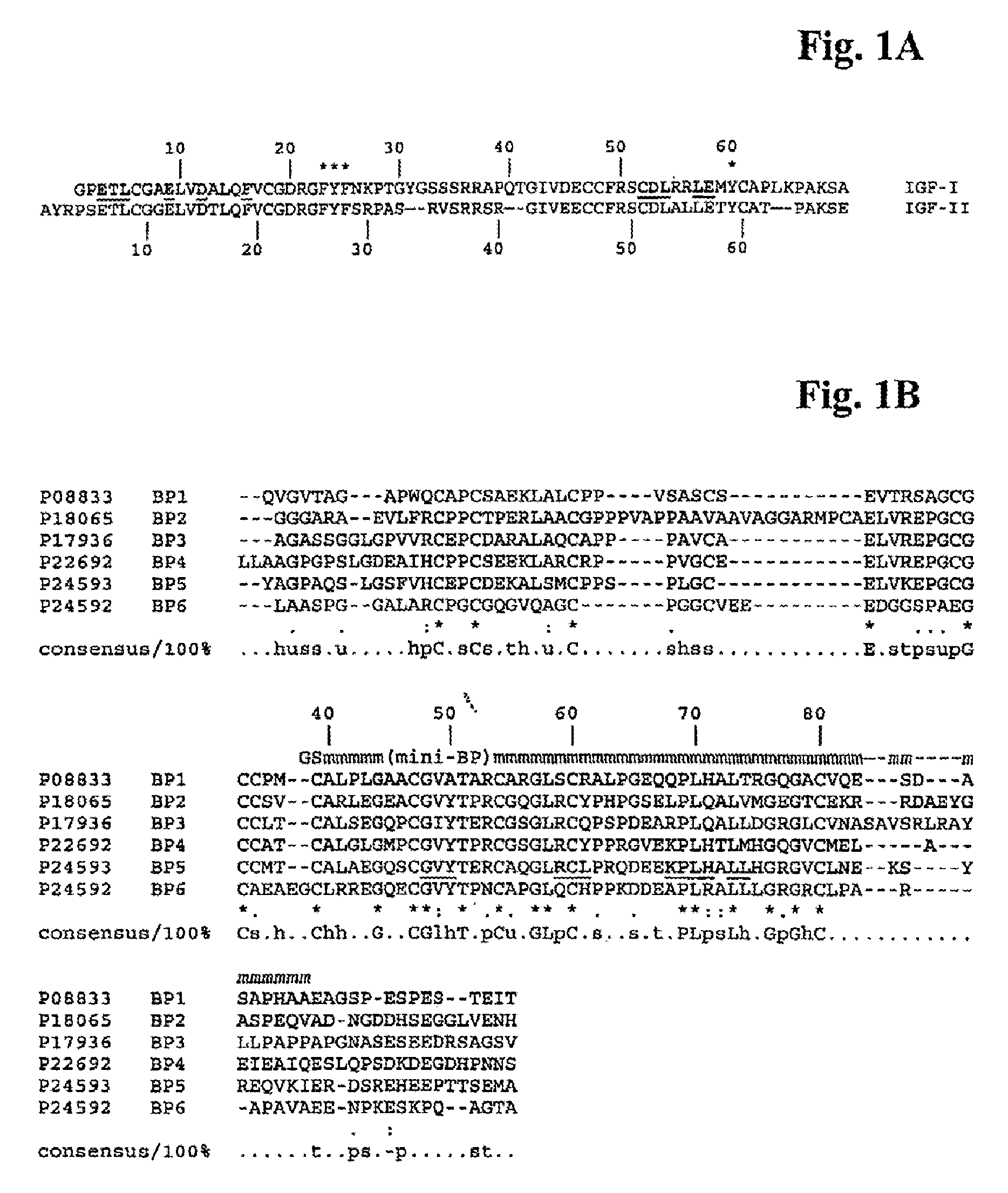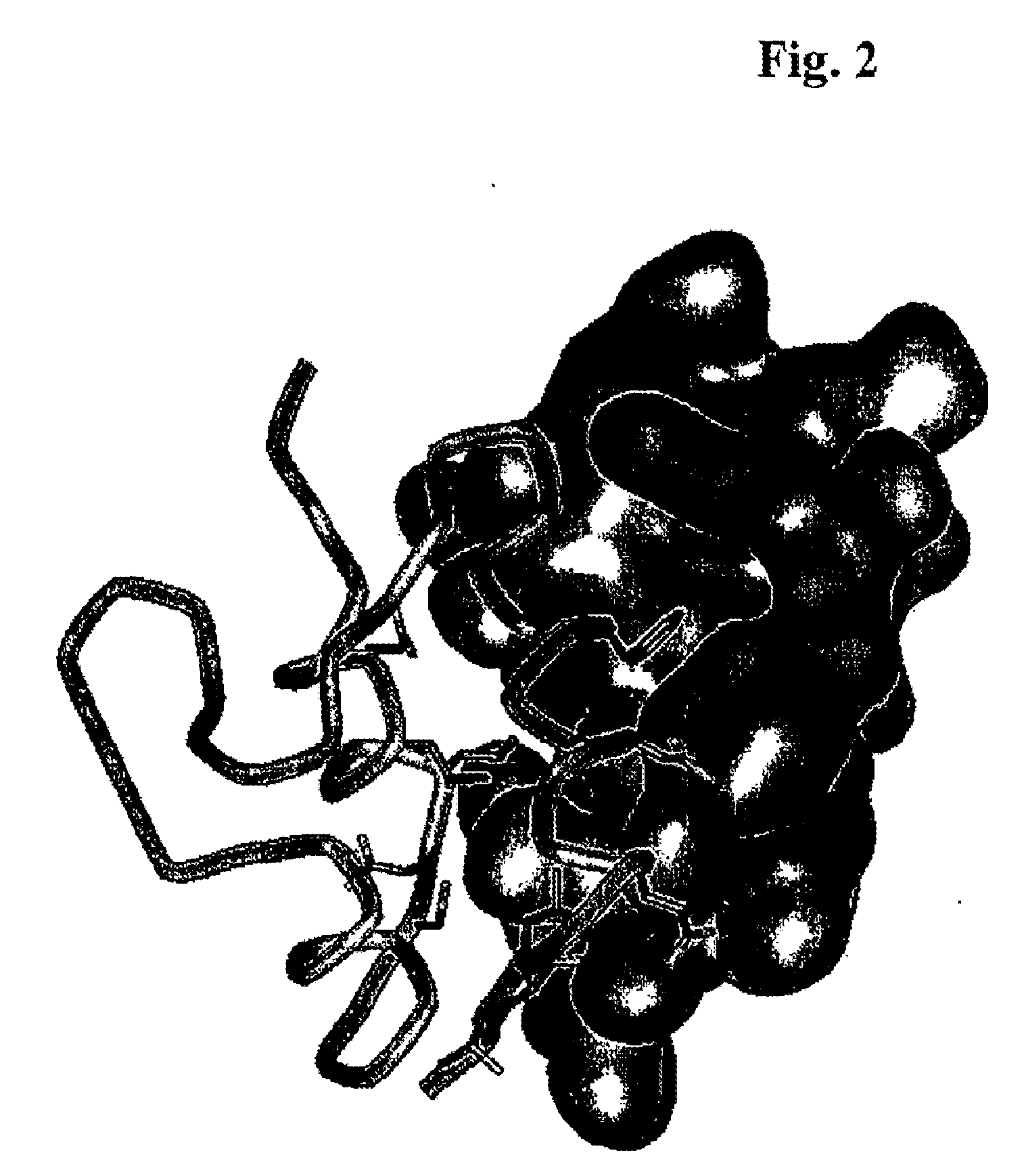Mutants of IGF Binding Proteins and Methods of Production of Antagonists Thereof
a technology of igf binding proteins and mutants, which is applied in the field of igf binding protein mutants, can solve the problems of insufficient therapeutic intervention of pegylated igfbp-1, inability to be produced economically, and inability to be administered to humans through established procedures, etc., and achieves enhanced affinity and increased affinity.
- Summary
- Abstract
- Description
- Claims
- Application Information
AI Technical Summary
Benefits of technology
Problems solved by technology
Method used
Image
Examples
example 1
Crystallization, Data Collection and Derivatization
[0084]Mini-IGFBP-5 was produced as described by Kalus, W., et al., in EMBO J. 17 (1998) 6558-6572 and in Example 6, and IGF-I was obtained from OvoPepi, Australia. Crystallization was successful with 10% Jeffamine M-600, 0.1 M sodium citrate, 0.01 M ferric chloride, pH 5.6. Within 11 days, crystals appeared at 4° C., growing to a final size of about 0.3×0.2×0.2 mm3. They belong to the cubic space group P213 and have unit cell dimensions a, b, c=74.385 Å, with one complex molecule per asymmetric unit. Soaking in precipitation buffer with heavy atom compounds yielded a derivative K2PtCl4 (2.7 mM, 3 d) which was interpretable. All diffraction data were collected using a 300 mm MAR Research (Hamburg, Germany) image plate detector mounted on a Rigaku (Tokyo, Japan) RU300 rotating anode X-ray generator with graphite monochromatized CuKα radiation. All image plate data were processed with MOSFLM (Leslie, A. G. W., Molecular Data in Process...
example 2
Phase Calculation, Model Building and Refinement
[0085]The structure of the IGF / mini-IGFBP-5 complex was solved by the single isomorphous replacement (s.i.r.) method using one heavy atom derivative described above. Derivative data was analyzed with the native data set, first using isomorphous difference Patterson maps and employing the Patterson vector superposition methods implemented in SHELX-97 (Sheldrick, G., Tutorial on automated Patterson interpretation to find heavy atoms, in: Moras, D., Podjarny, A. D., and Thierry, J. C. (eds.), Crystallographic Computing 5 (1991), Oxford University Press, Oxford, UK, pp. 145-157). The 2 heavy sites locations were confirmed by difference Fourier methods with appropriate initial single site s.i.r. phases using CCP4 programs. The refinement of heavy atom parameters and calculation of s.i.r. phases were done with SHARP (de la Fortelle, E., and de Bricogne, G., Methods Enzymol. 276 (1997) 472-494). The final parameters are given in Table 8. The ...
example 3
Determination of the Binding Affinity of IGFBP Mutants
[0087]The IGF-binding properties of wildtype and mutant fragments and full-length IGFBPs were quantitatively analyzed by BIAcore biosensor measurements. BIAcore 2000, Sensor Chip SA and HBS were obtained from BIAcore AB (Uppsala, Sweden). All experiments were performed at 25° C. and HBS (20 mM HEPES, 150 mM NaCl, 3 mM EDTA, pH 7.5) was used as a running buffer and for the dilution of ligands and analytes. Biotinylated IGF-I was immobilized at a concentration of 5 nM and 10 nM in HBS at a flow rate of 5 μl / min to the strepavidin coated sensor chip resulting in signals of 40 and 110 resonance units (RU). Biotinylated IGF-II was immobilized at a concentration of 5 nM in HBS resulting in a signal of 20 RU. An empty flow cell was used as control for unspecific binding and bulk effects. The low ligand concentration was necessary to limit mass transport limitations and rebinding. For the same reason all kinetic experiments were performe...
PUM
| Property | Measurement | Unit |
|---|---|---|
| surface area | aaaaa | aaaaa |
| concentration | aaaaa | aaaaa |
| weight | aaaaa | aaaaa |
Abstract
Description
Claims
Application Information
 Login to View More
Login to View More - R&D
- Intellectual Property
- Life Sciences
- Materials
- Tech Scout
- Unparalleled Data Quality
- Higher Quality Content
- 60% Fewer Hallucinations
Browse by: Latest US Patents, China's latest patents, Technical Efficacy Thesaurus, Application Domain, Technology Topic, Popular Technical Reports.
© 2025 PatSnap. All rights reserved.Legal|Privacy policy|Modern Slavery Act Transparency Statement|Sitemap|About US| Contact US: help@patsnap.com



